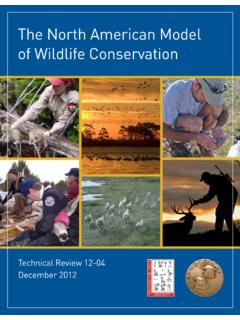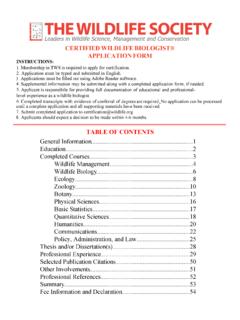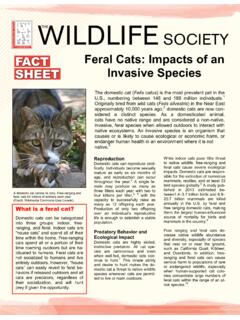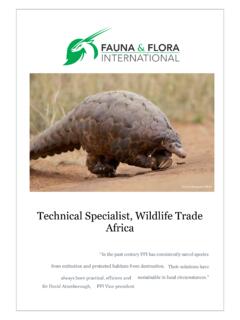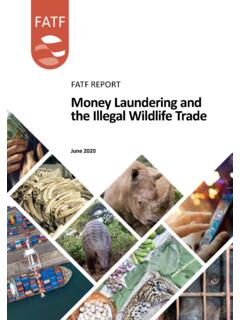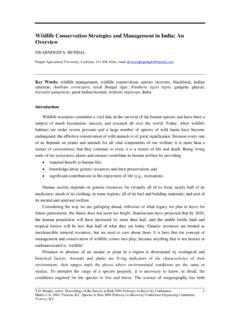Transcription of The North American Model of Wildlife Conservation
1 1 The North American Model of Wildlife Conservation Technical Review 12-04 December 2012 The North American Model of Wildlife Conservation iCitationOrgan, , V. Geist, Mahoney, S. Williams, Krausman, Batcheller, Decker, R. Carmichael, P. Nanjappa, R. Regan, Medellin, R. Cantu, McCabe, S. Craven, Vecellio, and Decker. 2012. The North American Model of Wildlife Conservation . The Wildlife Society Technical Review 12-04. The Wildlife Society, Bethesda, Maryland, USA. Series Edited byTheodore A. BookhoutCopy Edit and DesignTerra Rentz (AWB ), Managing Editor, The Wildlife SocietyLisa Moore, Associate Editor, The Wildlife SocietyMaja Smith, Graphic Designer, MajaDesign, Images Front cover, clockwise from upper left: 1) Canada lynx (Lynx canadensis) kittens removed from den for marking and data collection as part of a long-term research study.
2 Credit: John F. Organ; 2) A mixed flock of ducks and geese fly from a wetland area. Credit: Steve Hillebrand/USFWS; 3) A researcher attaches a radio transmitter to a short-horned lizard (Phrynosoma hernandesi) in Colorado s Pawnee National Grassland. Credit: Laura Martin; 4) Rifle hunter Ron Jolly admires a mature white-tailed buck harvested by his wife on the family s farm in Alabama. Credit: Tes Randle Jolly; 5) Caribou running along a northern peninsula of Newfoundland are part of a herd compositional survey. Credit: John F. Organ; 6) Wildlife veterinarian Lisa Wolfe assesses a captive mule deer during studies of density dependence in Colorado. Credit: Ken Logan/Colorado Division of would like to thank The Boone and Crockett Program at the University of Montana for providing financial support for publication. This report is copyrighted by TWS, but individuals are granted permission to make single copies for noncommercial purposes.
3 To view or download a PDF of this report, or to order hard copies, go to: : 978-0-9830402-3-1 The North American Model of Wildlife Conservation The Wildlife Society and The Boone and Crockett ClubTechnical Review 12-04 - December 2012 The North American Model of Wildlife Conservation iiThe North American Model of Wildlife Conservation iiiGordon R. Batcheller (CWB )New York State Div. of Fish, Wildlife & Marine Resources625 BroadwayAlbany, NY 12233 USAT homas A. Decker (CWB )Vermont Fish and Wildlife Department103 South Main StreetWaterbury, VT 05671 USAR obert CarmichaelDelta Waterfowl FoundationSite 1, Box 87 Keewatin, Ontario POX 1C0 CAPriya NanjappaAssociation of Fish and Wildlife Agencies444 North Capitol Street, NW, Suite 725 Washington, DC 20001 USAR onald Regan (CWB )*Association of Fish and Wildlife Agencies444 North Capitol Street, NW, Suite 725 Washington, DC 20001 USAR odrigo A.
4 MedellinInstituto de Ecolog a, UNAMAp. Postal 70-27504510 Ciudad Universitaria, D. F. MEXICOJohn F. Organ (Chair, CWB )*, ** Fish and Wildlife Service300 Westgate Center DriveHadley, MA 01035 USAV alerius Geist*Faculty of Environmental Design (Emeritus)2500 University Dr. NWUniversity of CalgaryCalgary, Alberta, T2N 1N4 CAShane P. Mahoney*Sustainable Development and Strategic Science BranchDepartment of Environment and Box 8700St. John s, NL A1B 4J6 CASteven Williams* Wildlife Management Institute1440 Upper Bermudian RoadGardners, PA 17324 USAPaul R. Krausman (CWB )*Boone and Crockett Professor of Wildlife ConservationWildlife Biology ProgramCollege of Forestry and Conservation32 Campus DriveUniversity of MontanaMissoula, Montana 59812 USAT echnical Review Committee on The North American Model of Wildlife Conservation *Professional members of the Boone and Crockett Club** The findings and conclusions in this article are those of the author and do not necessarily represent the views of the Fish and Wildlife Cantu (CWB )Texas Parks and Wildlife Department151 Las Lomas Angelo, TX 76901 USAR ichard E.
5 McCabe* Wildlife Management Institute1424 NW Carlson Road Topeka, Kansas 66615 USAS cott CravenDepartment of Wildlife EcologyRoom 226 Russell Laboratories University of Wisconsin 1630 Linden Drive Madison WI 53706 USAGary M. VecellioIdaho Fish and Game4279 Commerce CircleIdaho Falls, ID 83401 USAD aniel J. Decker (CWB )Human Dimensions Research Unit206 Bruckner Hall Department of Natural Resources Cornell UniversityIthaca, NY 14853 USAThe North American Model of Wildlife Conservation ivThe North American Model of Wildlife Conservation vForeword viAcknowledgements viiExecutive Summary viiiIntroduction 1 Historical Overview
6 3 Canada and the United States Implementation in Canada and the United States 6 Canada 6 United States 8 Review of Model Components 11 1.
7 Wildlife Resources Are a Public Trust 112. Markets for Game Are Eliminated 143. Allocation of Wildlife Is by Law 16 4. Wildlife Can Be Killed Only for a Legitimate Purpose 18 5. Wildlife Is Considered an International Resource 196. Science Is the Proper Tool to Discharge Wildlife Policy 207. Democracy of Hunting Is Standard 23 Sustaining and Building Upon the Model 24 Funding 25 Wildlife Markets 25 Firearms Rights and Privileges
8 25 Habitat Considerations 26 Taxa Inclusivity 28 Governance 28 The Future of the Model 29 Summary and Recommendations 30 Literature Cited 31 Appendix: Status of Wildlife Management in Mexico 35 Table of ContentsThe North American Model of Wildlife Conservation vi residents of The Wildlife Society (TWS) occasionally appoint ad hoc committees to study and report on selected Conservation issues.
9 The reports ordinarily appear as technical reviews or position statements. Technical reviews present technical information and the views of the appointed committee members, but not necessarily the views of their technical review focuses on the set of principles known as the North American Model of Wildlife Conservation and was developed in partnership with the Boone and Crockett Club. The review is copyrighted by TWS, but individuals are granted permission to make single copies for non-commercial purposes. All technical reviews and position statements are available in digital format at Hard copies may be requested or purchased from:The Wildlife Society5410 Grosvenor Lane, Suite 200 Bethesda, MD 20814 Phone: (301) 897-9770 Fax: (301) a fawn during studies of density dependence in Colorado. Courtesy of the Colorado Division of North American Model of Wildlife Conservation vii e acknowledge the support of TWS Presidents in office during preparation of this report, including President Paul R.
10 Krausman and Past Presidents Tom Ryder, Bruce Leopold, Tom Franklin, and Dan Svedarsky. We are grateful to Theodore Bookhout for his thorough editing. Members of The Wildlife Society Council John McDonald, Rick Baydack, Darren Miller, and Ashley Gramza (Student Liaison) provided comments and support. The Wildlife Society editors Laura Bies, Terra Rentz, and Christine AcknowledgmentsCommissioners representing Canada, Mexico, and the United States at the 1909 North American Conservation Congress. President Theodore Roosevelt sits at center. Credit: Forest History provided encouragement, invaluable suggestions, and edits. This review was approved for development in March 2007 by then-President John F. Organ and approved for publication in October 2012 by then-President Paul R. Krausman. We would like to recognize the financial support provided by both the Boone and Crockett Club and The Boone and Crockett Program at the University of Montana for publication, printing, and North American Model of Wildlife Conservation viiiwhether we are prepared to address challenges that lay ahead.

